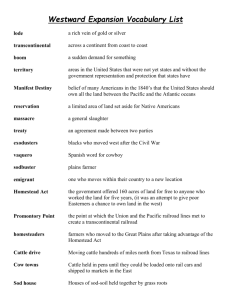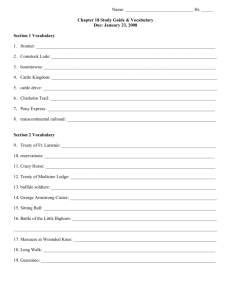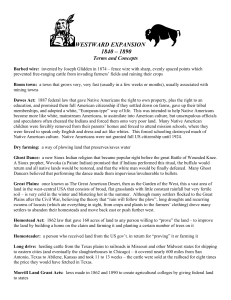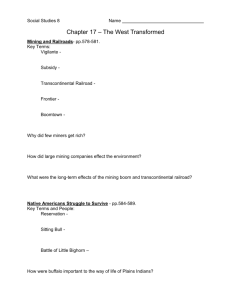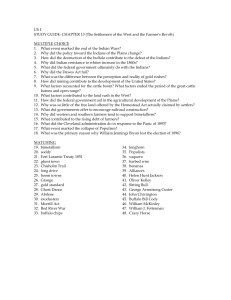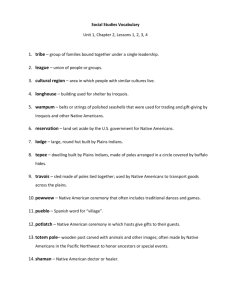Americans Move West Miners, Ranchers, and railroads~The Big Idea
advertisement
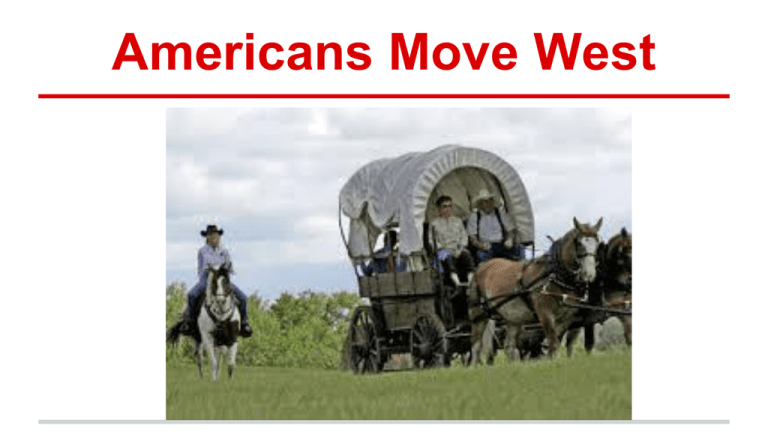
Americans Move West Miners, Ranchers, and railroads~The Big Idea As more settlers moved West, mining, ranching, and railroads soon transformed the western landscape. Main Ideas 1.A mining boom brought growth to the West. 2.The demand for cattle created a short lived Cattle Kingdom on the Great Plains. 3.East and West were connected by the transcontinental railroad. establish to set up or create frontier an undeveloped area Need to know~Mining boom The addition of the state of California to the union, the western boundary of the United States reached the Pacific Ocean. Comstock Lode Henry Comstock discovered a huge deposit of gold and silver in Nevada, started mining boom boomtowns communities that grew suddenly when a mine opened Cattle Kingdom Great Plains area where many ranchers raised cattle in the late 1800’s. Need to know~Cattle Kingdom The Texas longhorn was a very hardy breed of cattle and could withstand the harsh weather of the midwest. ranchers grazed huge herds on public land called the open range. vaqueros- mexican ranch hands who cared for cattle and horses Cattle Drive long journeys cowboys herded cattle to the market or to the northern Plains for grazing. Chisholm Trail a popular route for cattle drives, San Antonio, Tx to Abilene, KS. Pony Express a system of messengers on horseback transcontinental railroad a railroad that would cross the continent and connect the East to the West. Need to know~transcontinental R.R. Golden spike -connected the Union Pacific and Central Pacific railroad Pacific Railway Acts- loans and grants that were given to help build the railroad. Causes and Effects of westward exp. Causes ● New land for Settlers/ranchers ● Mineral resources ● Business to support settlers, ranchers, and miners ● Immigration Effects New towns railroads across the continent cattle kingdom Wars for the West~The Big Idea Native Americans and the U.S. Government came into conflict over land in the west. Main Idea As settlers moved to the Great Plains, they encountered the Plains Indians. The U.S. Army and Native Americans fought in the northern plains, the southwest and the far west. Despite efforts to reform U.S. policy toward Native Americans, conflict continued. Need to know~ Settlers & Indians Plains Indians depended on two animals for survival, the horse and the buffalo. Crazy Horse- ambushed and killed 81 U.S. cavalry troops. Treaty of Fort Laramie the first major treaty between the U.S. government and Plains Indians, first U.S. attempt to avoid disputes with the Indians reservation areas of federal land set aside for Native Americans Treaty of Medicine Lodge most southern Plains Indians agreed to live on reservations Buffalo soldiers American soldiers, some African American, sent to force the Indians out from their homeland General George Armstrong Custer found Gold in the Black Hills of the Dakotas defeated by Sioux forces at “Custer’s Last Stand” Sitting Bull Leader of the Lakota Sioux protested U.S. demands for their land defeated Custer Massacre at Wounded Knee U.S. Army shot and killed 150 Sioux indians last major incident on the Great Plains Need to know~ Fighting on the Plains ●U.S. raids on Navajo homes/fields/livestock ○ caused Navajo to run out of food and thus led to the long walk ○ Nez Perce- tried to escape to Canada, caught and sent to reservation in Oklahoma ●Geronimo- An Apache who avoided capture for many years Long Walk 300 mile trek across the desert to a reservation, Bosque Redondo, New Mexico Geronimo An Apache Indian who continued to fight for his land long after others stopped. He surrendered to U.S. forces in September of 1886. Ghost Dance a religious movement that predicted the arrival of paradise for Native Americans Sarah Winnemuca a Paiute Indian who called for reform spoke out on problems for the fair treatment of her people gave lectures on problems of the reservation system Dawes General Allotment Act an agreement that made land ownership private rather than shared. Farming & Populism ~ The Big Idea Settlers on the Great Plains created new communities and unique political groups. Main Ideas Many Americans started new lives on the Great Plains. Economic challenges led to the creation of farmers’ political groups. By the 1890’s, the western frontier had come to an end. Homestead Act This act gave government owned land to small farmers. Morrill Act This grant gave more than 17 million acres of federal land to the states. Exodusters Were southerners that made a mass exodus, or departure from the South. sodbusters Plains farmers were called this because of their hard work breaking up the sod. dry farming - Is a new method of farming that shifted the focus away from water-dependent crops such as corn. Annie Bidwell She was one of the founders of Chico, California, who used her influence to support a variety of moral and social causes such as women’s suffrage and temperance. National Grange - was a social and educational organization for farmers deflation - a decrease in the money supply and overall lower prices William Jennings Bryan - was a candidate that supported free silver coinage (making as many silver coins as possible) Populist Party - a political party that supported the “free called for the and unlimited coinage government to own of silver” railroads, telephone and telegraph systems
